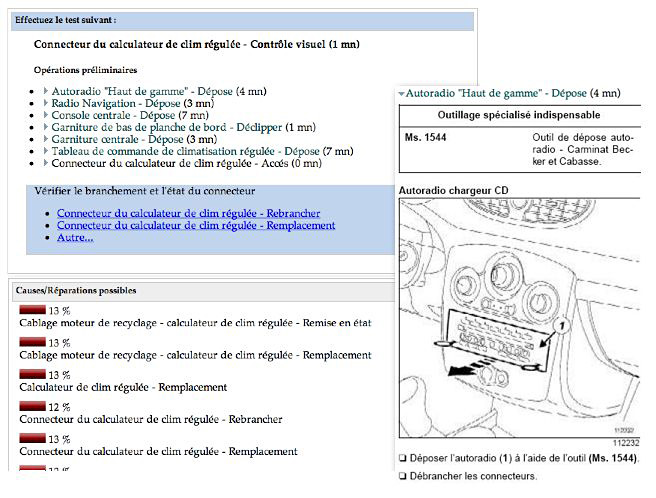Integrating disparate applications and data sources in a large corporation is expensive in terms of resources and time. Using Semantic Web technologies can help to dramatically cut down these costs. RDF and OWL are open and mature Semantic Web standards, which can be used as a semantic bus for easy sharing of information between systems. These standards were the natural choice for a prototype in the area of car repair and diagnostic documentation, because it is a field where many objects have to be shared amongst many different systems ranging from engineering to repair shops.
In 2006, using a technology that had been developed at Renault, we built a probabilistic induction tool aimed at diagnostics. The goal being to show that, rather than having all of the procedures written in manuals as they are today, an engine could compute them on the fly, in a way that minimizes the cost of diagnostic. However, we found that our information systems were not able to provide the data that was needed for the engine. Most systems at Renault are currently geared toward the management of documents describing repair and diagnostics, and not toward the management of the corresponding concepts themselves. The systems that do deal with operations don’t provide a sharable identity for them, so they are unable to easily exchange information about them. Another problem was that data was simply not available at the required level of granularity, except occasionally as unstructured text.
We became convinced that a repository of possible repair and diagnostic operations would have great value for the whole of Information Systems. Therefore, our goal moved to building the prototype of such a repository, and to prove its value through the diagnostic engine. OWL was used to model the repository and the related concepts. A REST based services architecture was used with RDF for information exchange. This architecture enables users to progressively discover information about repair, navigating the repository in the same way as would be done with traditional Web pages. In a diagnostic session, the user is instructed by the application to perform tests and enter results.
Our repository has been designed to describe all possible repair and diagnostic operations. This involved modeling several key concepts of the field and their relations. These included symptoms, default trouble codes, part failures, diagnostic tests, disassembly graphs (paths for disassembling components), and product diversity specification. We found OWL to be a very effective way to describe the I/O of a system, for instance to define the input data that our reasoning tools expect (a set of Boolean and Probability constraints between aforementioned items).
Repair and diagnostic operations, as well as related notions, were promoted to the rank of concepts identified by HTTP URIs. Dereferencing these URIs returns information about them in either RDF or HTML, depending upon content negotiation. Conforming to the guidelines for the publishing of linked data on the web, we implemented a REST web services architecture: connecting to the repair and diagnostic documentation service is just a matter of accessing URIs, (e.g. the URI of a given symptom, or of a trouble code) and of following the links to other resources (e.g. a diagnostic test) included in the result. This is quiet different from a WS-* web service: when connecting to such a service, a client application has to be aware of the API of the service, and include code dedicated to it. Here, the returned RDF data can be parsed by a generic parser: nothing more is needed to fully understand its meaning. A generic RDF browser could almost be used as the client application (the only missing feature is the handling of forms, for which no vocabulary has been standardized yet).

Figure 1: Screenshot of the system. Two successive commented screenshots (1st phase and 2nd phase) show the system’s usage in more details
Despite their potential, the usage of Semantic Web technologies in the enterprise is still not mainstream. They are sometimes perceived as yet another technological hype that promises easy exchange of information, and this message has been heard before. People are also not sure what Semantic Web technologies add to Web Services. However, we have had the opportunity to highlight some of the benefits of using RDF and OWL. Thanks to the clear and powerful data model provided by RDF, which gives a high level of a priori understanding, we were able to build services that do not require client applications to include code dedicated to their use.
Some benefits of the Semantic Web will shine even more brilliantly in the future, for example, the benefit of a flexible information bus for data exchange fully manifests itself when a large number of applications need to be connected.
Should OWL modeling be considered as extra work? Well, we do not think so: one always has to do some modeling when it comes to developing software! OWL allowed us to put a lot of business knowledge into the data, which is a far better approach that having it hard-coded in programs!
Our primary goal is now to prove that Renault will be able to produce the necessary data in RDF and OWL. We are very confident that this can happen, as most of the data already exists. It is just located in disparate systems of the engineering department, for example, in databases, spreadsheets, technical schemata, and functional graphs. Repair and diagnostic experts use this information to write today’s repair and diagnostic manuals - a process in which all of the underlying semantics is lost. We will now develop the tools to help the same experts produce the repository data. Easy aggregation of RFD data, the ability to provide an RDF view of databases , and the modeling that we have already undertaken, will be useful in fulfilling this task.
© Copyright 2007, Renault